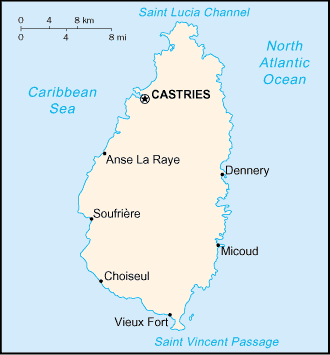Country name:
conventional long form: none conventional short form:Saint Lucia

Government type:
parliamentary democracy and a Commonwealth realm

Capital:
name:Castriesgeographic coordinates:14 00 N, 61 00 W time difference:UTC-4 (1 hour ahead of Washington, DC, during Standard Time)

Administrative divisions:
10 districts; Anse-la-Raye, Canaries, Castries, Choiseul, Dennery, Gros-Islet, Laborie, Micoud, Soufriere, Vieux-Fort

Independence:
22 February 1979 (from the UK)

National holiday:
Independence Day, 22 February (1979)

Constitution:
previous 1958, 1960 (preindependence); latest presented 20 December 1978, effective 22 February 1979; note - a constitutional reform report was submitted to the St. Lucian Parliament in April 2013 (2013)

Legal system:
English common law

International law organization participation:
has not submitted an ICJ jurisdiction declaration; accepts ICCt jurisdiction

Suffrage:
18 years of age; universal

Executive branch:
chief of state:Queen ELIZABETH II (since 6 February 1952); represented by Governor General Dame Pearlette LOUISY (since September 1997)head of government:Prime Minister Kenny Davis ANTHONY (since 30 November 2011) cabinet:Cabinet appointed by the governor general on the advice of the prime minister elections:the monarchy is hereditary; the governor general appointed by the monarch; following legislative elections, the leader of the majority party or the leader of a majority coalition usually appointed prime minister by the governor general; deputy prime minister appointed by the governor general

Legislative branch:
bicameral Parliament consists of the Senate (11 seats; six members appointed on the advice of the prime minister, three on the advice of the leader of the opposition, and two after consultation with religious, economic, and social groups) and the House of Assembly (17 seats; members elected by popular vote to serve five-year terms)elections:House of Assembly - last held on 28 November 2011 (next to be held in 2016) election results:House of Assembly - percent of vote by party - SLP 49.68%, UWP 45.83%; seats by party - SLP 11, UWP 6

| | Judicial branch:
highest court(s):the Eastern Caribbean Supreme Court (ECSC) is the itinerant superior court of record for the 9-member Organization of Eastern Caribbean States; the ECSC - with its headquarters on St. Lucia - is headed by the chief justice and is comprised of the Court of Appeal with 3 justices and the High Court with 16 judges; sittings of the Court of Appeal and High Court rotate among the member states; 3 High Court judges reside on Saint Lucianote - Saint Lucia is a member of the Caribbean Court of Justice judge selection and term of office:Eastern Caribbean Supreme Court chief justice appointed by Her Majesty, Queen ELIZABETH II; other justices and judges appointed by the Judicial and Legal Services Commission; Court of Appeal justices appointed for life with mandatory retirement at age 65; High Court judges appointed for life with mandatory retirement at age 62 subordinate courts:magistrate's court

Political parties and leaders:
Lucian People's Movement or LPM [Therold PRUDENT]Saint Lucia Labor Party or SLP [Kenny ANTHONY] United Workers Party or UWP [Stephenson KING]

Political pressure groups and leaders:
NA

International organization participation:
ACP, AOSIS, C, Caricom, CD, CDB, CELAC, FAO, G-77, IBRD, ICAO, ICRM, IDA, IFAD, IFC, IFRCS, ILO, IMF, IMO, Interpol, IOC, ISO, ITU, ITUC (NGOs), MIGA, NAM, OAS, OECS, OIF, OPANAL, OPCW, Petrocaribe, UN, UNCTAD, UNESCO, UNIDO, UPU, WCO, WFTU (NGOs), WHO, WIPO, WMO, WTO

Diplomatic representation in the US:
chief of mission:Ambassador Sonia Merlyn JOHNNY (since 12 September 2012)chancery:3216 New Mexico Avenue NW, Washington, DC 20016 telephone:[1] (202) 364-6792 through 6795 FAX:[1] (202) 364-6723 consulate(s) general:Coral Gables (FL), New York

Diplomatic representation from the US:
name:'Sons and Daughters of St. Lucia'lyrics/music:Charles JESSE/Leton Felix THOMAS note:adopted 1967 |











